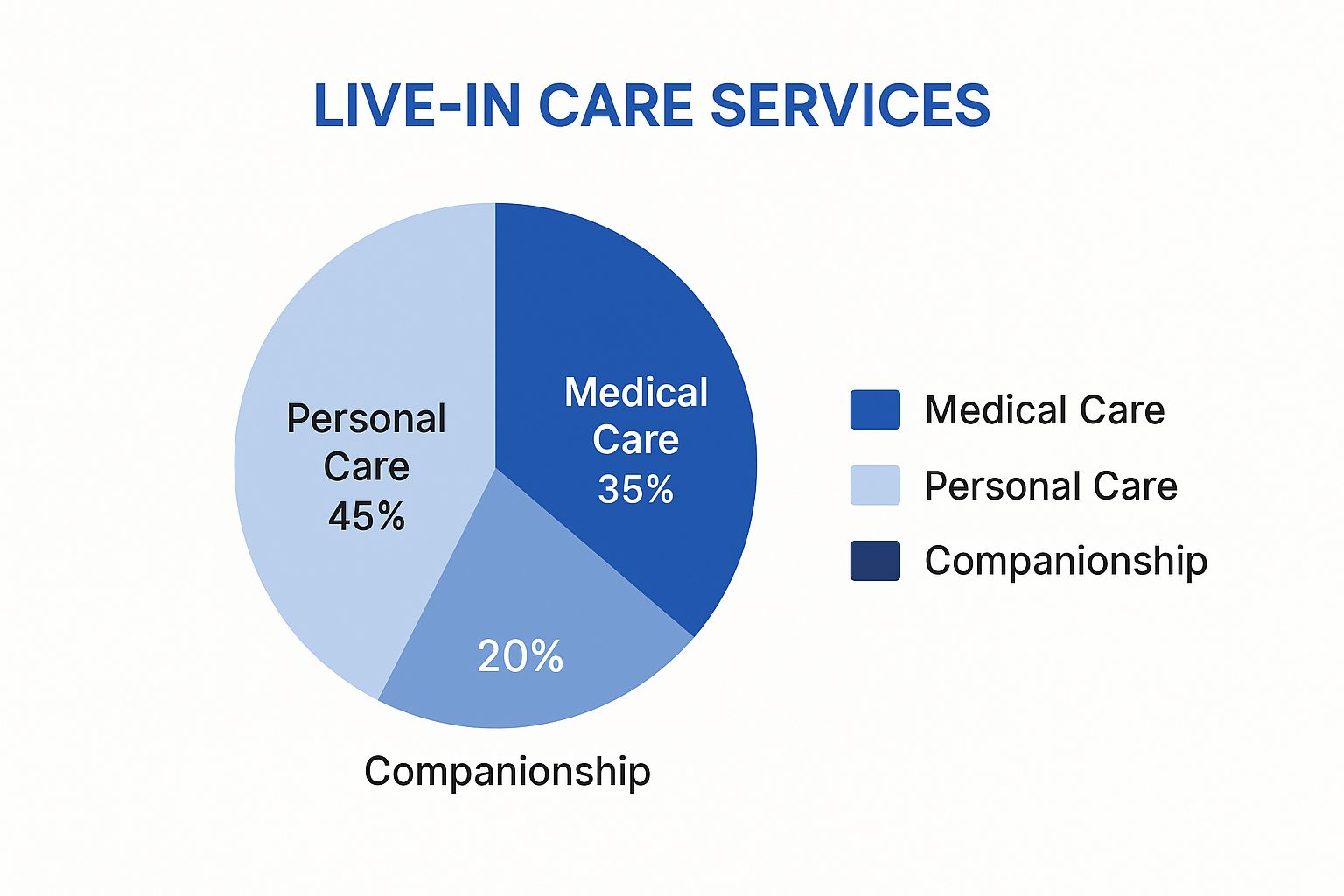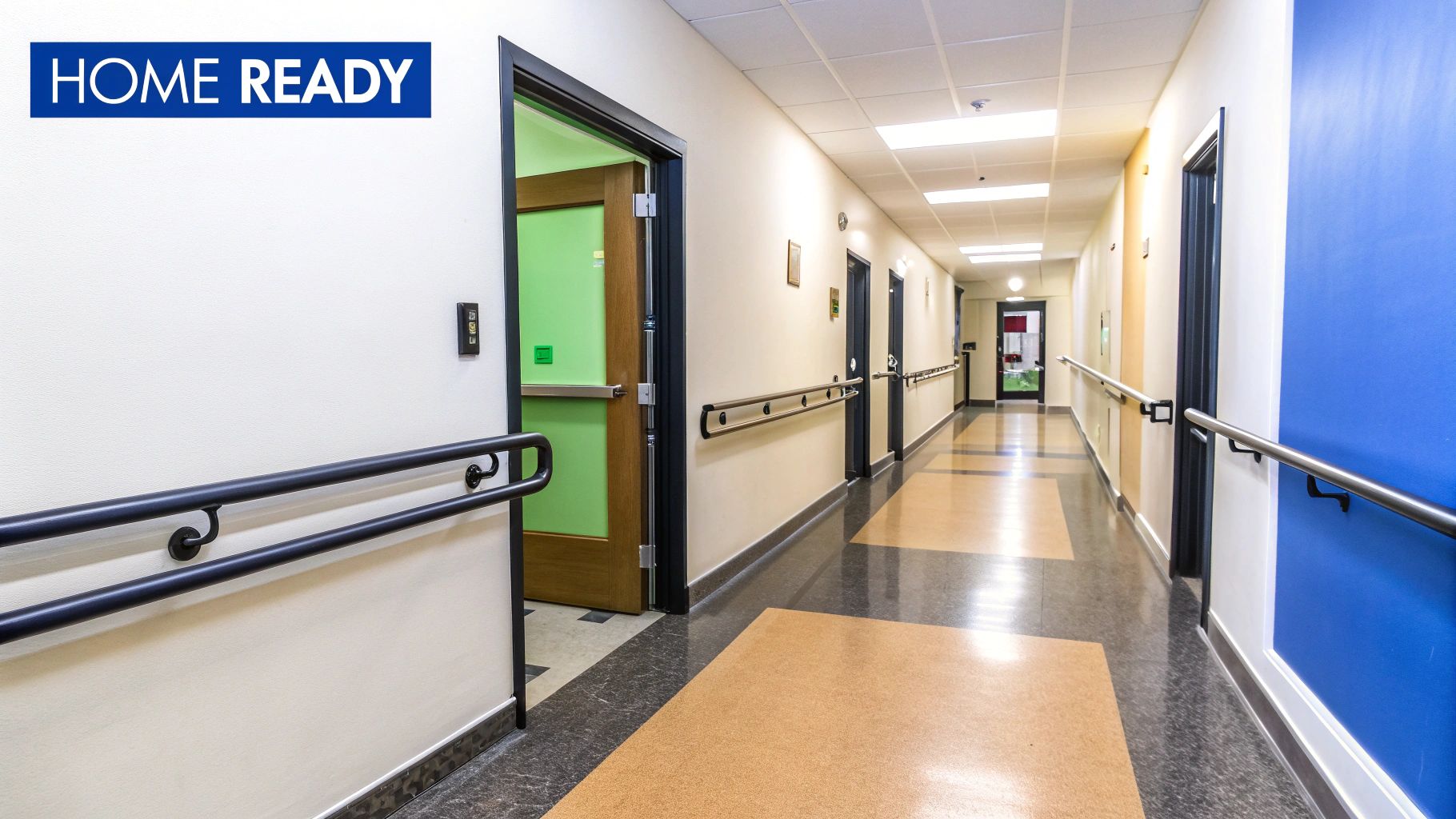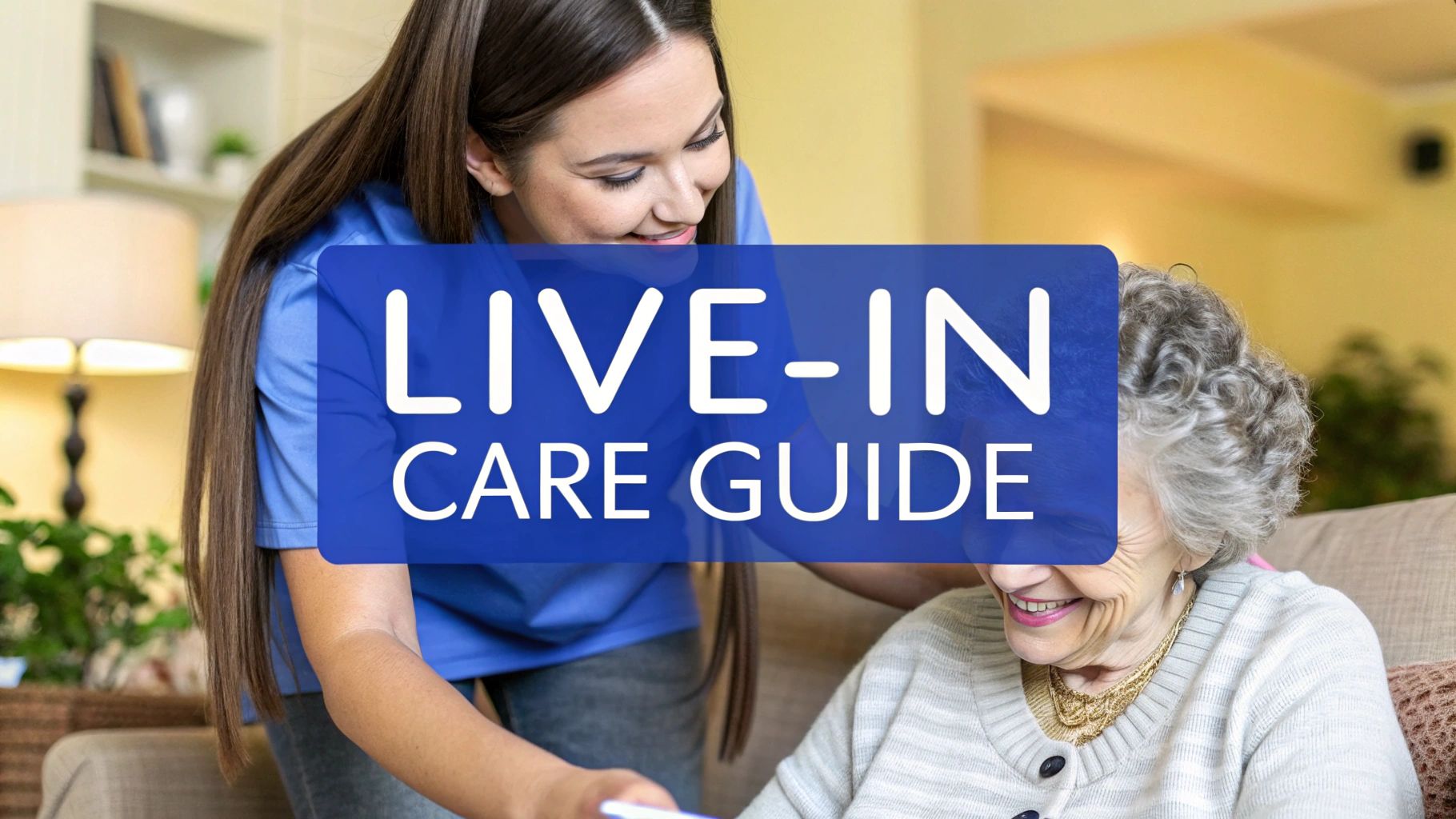Understanding Live-In Care: What Families Really Experience

Imagine live-in care as having a trusted family friend move in to support your loved one. It's not just about someone being there; it's about building a real connection and creating a comforting home environment. Daily routines revolve around your loved one's specific needs, respecting their independence and dignity.
For example, a caregiver might share a favorite hobby with your parent, cook meals they enjoy, or assist with personal care while maintaining their privacy.
This personalized approach goes beyond simple companionship. Live-in care flexes to meet different needs. Maybe your loved one is feeling isolated and just needs a friendly face for meals and conversation. Or perhaps they have complex medical needs requiring help with medications, mobility, and other crucial tasks. This adaptability makes live-in care a practical solution for a wide variety of circumstances.
The transition to live-in care can be surprisingly easy with a little planning. Families are often amazed at how quickly their loved one adapts and how much it improves their well-being. And the benefits extend to the whole family. Knowing a loved one is safe and well-cared for brings peace of mind and reduces stress. This allows families to focus on simply enjoying time together, rather than constantly providing care.
Long-term care is becoming increasingly important. Around 70% of seniors will need some type of long-term care in their lifetime. On average, this care lasts about three years, highlighting the need for sustainable solutions. Discover more insights on long-term care needs.
Many families find themselves saying, "I wish we'd considered this sooner." They often underestimate the burden they're carrying, juggling their own lives with the increasing demands of caring for an aging parent. Live-in care isn't simply about having someone "watch" a loved one. It's about a partnership that improves their quality of life and offers essential support for the whole family. Take a look at this: NJ Care Giving Image This shows how individual care plans can really make a difference. It also highlights the importance of understanding what families experience with live-in care—a choice that often becomes not just a practical solution, but a truly positive experience.
Why Smart Families Are Choosing Live-In Care Now

Think about families today compared to a generation or two ago. People are living longer, which is fantastic! But families are often smaller and spread out across the country. This creates a real challenge when it comes to caring for aging parents.
Adult children might be juggling careers and raising their own families hundreds of miles away, making it tough to provide the regular support their parents need. This distance creates a caregiving gap that’s increasingly difficult to bridge.
This is one reason why live-in care for elderly loved ones is becoming a more practical solution. It’s less about luxury and more about necessity. The traditional image of a large, extended family all living under one roof is simply less common these days.
Plus, there's a growing recognition that a familiar environment is crucial for a senior's well-being. Think about it – staying in their own home, surrounded by comforting memories and established routines, can greatly enhance their quality of life.
This shift in family structures and a greater appreciation for aging in place are fueling the demand for live-in care. As a result, waiting lists for qualified caregivers are getting longer. Interestingly, many families who were initially hesitant about having a caregiver in the home often become the biggest advocates once they see the positive impact firsthand.
The global picture of elder care is also evolving quickly. By 2030, a staggering 1 in 6 people globally will be 60 or older. This demographic shift significantly increases the need for care services. Discover more insights on global aging trends.
Beyond demographics, how we view aging itself is changing. Seniors are more active and engaged than previous generations, and they want care options that respect their independence and empower them to live full lives. This desire for personalized, home-based support further contributes to the growing interest in live-in care arrangements. It reflects a broader movement toward care that truly puts individual needs and preferences first, all within the comfort of home.
The Real Financial Picture: Investment Analysis That Makes Sense

The infographic above gives us a snapshot of the services provided in live-in care for elderly individuals. It breaks down the care into three key areas: personal care (45%), medical care (35%), and companionship (20%). Notice how personal care takes the biggest slice of the pie, followed closely by medical care. This shows us that live-in care isn't just about medical needs; it's about supporting daily tasks and emotional well-being too.
Let's be honest, providing live-in care for an elderly family member is a significant financial commitment. But smart families look beyond just the monthly cost. They're thinking about the value – what they get in return for that investment.
Comparing Costs and Value
Think about the alternatives for a moment. Nursing homes and assisted living facilities might seem cheaper at first glance. However, they often come with unexpected extra costs that quickly add up. These might include fees for personalized services, medication management, or even social activities. With live-in care, these services are often bundled into the overall price.
It's a bit like buying a car. That base model might seem attractive, but adding the features you actually need can significantly increase the price. Live-in care is often more like buying a well-equipped car from the start – a higher initial price, but more included.
Then there's the option of part-time home care services. While hourly rates can be tempting, coordinating multiple caregivers, filling scheduling gaps, and ensuring consistent care quality can quickly become a logistical and financial headache. This fragmented approach can also disrupt a senior’s routine and create emotional stress. Live-in care offers consistency and stability, essential for overall well-being.
To help illustrate the costs, let's look at a comparison table:
Live-In Care Cost Comparison: Comprehensive breakdown comparing monthly costs of live-in care versus nursing homes, assisted living, and part-time home care services.
| Care Type | Average Monthly Cost | Services Included | Flexibility Level |
|---|---|---|---|
| Live-in Care | $6,000 – $12,000 | Personal care, medical assistance, companionship, meal preparation, housekeeping | High, customized to individual needs |
| Nursing Home | $7,000 – $15,000+ | Room and board, medical care, some personal care | Limited, structured environment |
| Assisted Living | $4,000 – $8,000 | Room and board, some personal care, social activities | Moderate, some choices available |
| Part-Time Home Care | $2,000 – $6,000+ (depending on hours) | Personal care, some medical assistance | Varies depending on agency and caregiver availability |
Note: These are average costs and can vary depending on location, specific needs, and agency.
As you can see, while live-in care might appear more expensive upfront, the comprehensive nature of the services included and the high level of flexibility often make it a comparable or even more cost-effective option in the long run compared to other forms of care.
Exploring Financial Strategies
Beyond the direct costs, exploring financial options can make live-in care more manageable. Many families aren't aware of potential insurance coverage, tax deductions, and other financial strategies like long-term care insurance or reverse mortgages. Understanding these options can significantly impact your budget.
For instance, some long-term care insurance policies can cover a portion of in-home care expenses. Also, certain medical expenses related to live-in care may be tax deductible. A financial advisor specializing in elder care can help you navigate these complexities.
Budgeting for Peace of Mind
Ultimately, live-in care for an elderly loved one is an investment in their physical and emotional well-being, and your family's peace of mind. Knowing your loved one is safe, comfortable, and receiving personalized care is priceless. This peace of mind frees you to focus on spending quality time together, without the constant worry of managing caregiving logistics. When you factor in these intangible benefits, the true value of live-in care becomes clear. It's an investment in a better quality of life for everyone involved.
Benefits That Transform Daily Life for Entire Families
Live-in care isn't just about having someone in the home; it's about a whole new level of support that positively impacts the entire family. It's about those ripple effects—the unexpected benefits that you only truly understand once you've experienced them.
Enhanced Well-being and Recovery
Think of it this way: when you're sick, where do you feel most comfortable? Probably curled up at home, right? The same applies to seniors. Recovering from an illness in familiar surroundings, surrounded by their favorite things, can significantly speed up healing. Being at home reduces stress and boosts their sense of security, which is crucial for getting better. And this isn’t just a feeling; research shows that familiar environments have a real, positive impact on health.
A consistent caregiver also forms a close bond with the senior, making things like medication management much easier. Imagine someone who truly understands your loved one's routines and preferences. Medication reminders become less of a chore and more a natural part of the day. This can dramatically reduce medication errors, a serious concern for many families.
Having around-the-clock care also means fewer trips to the emergency room. A live-in caregiver can address minor health concerns before they become emergencies. It's like having a safety net, knowing someone is always there to watch over and respond to any changes in your loved one's health.
Strengthening Family Bonds
Families who have been using live-in care for a while often notice a beautiful shift. Family visits transform from caregiving sessions to quality time. Adult children can finally relax and connect with their parents, sharing stories and simply being present.
This change significantly reduces caregiver stress. Many adult children juggle work, family, and the added responsibility of caring for aging parents. Live-in care provides relief, letting them focus on other areas of their lives while knowing their parents are well-cared for. Learn more about support for NJ families.
Perhaps the most surprising benefit? Many families report that their relationships with their aging parents actually improve. With a professional caregiver handling the daily tasks, family interactions become more relaxed and positive. This renewed focus on connection strengthens bonds and creates lasting memories.
Preserving Dignity and Autonomy
Live-in care offers something truly valuable: the preservation of dignity and autonomy. Seniors maintain control over their daily lives—their routines, preferences, and environment. They can enjoy meals they like, on their own schedule, and participate in activities they love. This control is essential for maintaining self-esteem and overall well-being.
This personalized approach fosters independence. While receiving support when needed, seniors retain the freedom to make choices. This is a stark contrast to institutional settings, where routines are often rigid. The result is a more fulfilling and respectful experience that honors each person's unique life story. This translates to a higher quality of life for the senior and creates a more supportive experience for the whole family.
Let’s take a closer look at the benefits with this table:
Live-In Care Benefits Overview: Detailed comparison of benefits across emotional, physical, financial, and family impact categories
| Benefit Category | Specific Advantages | Impact Level | Family Feedback |
|---|---|---|---|
| Emotional Well-being | Reduced stress, increased sense of security, improved mood | High | "Mom seems so much happier and more relaxed now." |
| Physical Health | Faster recovery from illness, improved medication compliance, fewer emergency room visits | High | "Dad's health has been so much more stable since having a live-in caregiver." |
| Family Dynamics | Stronger family bonds, reduced caregiver stress, improved relationships | High | "We can actually enjoy our visits with Mom now, instead of just worrying about her care." |
| Autonomy & Dignity | Maintains control over daily routines, preserves independence, personalized care | High | "It's so important to us that Dad can still make his own choices and live life on his own terms." |
As you can see, the advantages of live-in care are significant and far-reaching, touching every aspect of a senior's life and their family's well-being.
Making The Right Choice: An Honest Assessment Framework
Live-in care for an aging loved one is a big decision, one that deserves careful thought and realistic expectations. It's not a universal solution, like trying to use a wrench when you need a screwdriver. Understanding this from the start can prevent headaches down the road. This section will walk you through an honest assessment, taking into account your family’s unique situation, your loved one's specific needs, and your home environment.
Is Live-In Care the Right Fit?
Imagine choosing the right tool for a project. A hammer is perfect for nails, but not so helpful with screws. Live-in care works beautifully in some situations but isn’t the best fit for every family. Let’s explore some key factors.
When Live-In Care Shines:
-
Growing Care Needs: If your loved one needs a bit more help each day, and family members are struggling to keep up, live-in care offers consistent support. This could include help with bathing, getting dressed, remembering medications, or preparing meals.
-
Combating Loneliness: Social isolation can deeply affect a senior’s well-being. Live-in care provides companionship, reducing feelings of loneliness and promoting emotional health.
-
Enhanced Safety: Worried about falls or other potential dangers? A live-in caregiver offers 24/7 supervision, providing peace of mind for both your loved one and your family.
-
Aging in Place: For seniors who cherish their independence and want to stay in their own homes, live-in care provides the support they need to age in place comfortably.
When Other Options Might Be Better:
-
Complex Medical Needs: If your loved one needs intensive medical care, a nursing home or skilled nursing facility might be more appropriate. These settings offer specialized medical professionals and equipment.
-
Reluctance to Accept Help: If your loved one strongly opposes having someone live in their home, starting with less intensive options, like visiting home care, might be a gentler approach.
-
Family Dynamics: Live-in care requires open communication and teamwork between the family and the caregiver. If family relationships are already strained, this arrangement might add more stress.
Timing and Crucial Conversations
Knowing when to make the move to live-in care is critical. Waiting too long can lead to crises, while transitioning too early might not be necessary. Consider these questions:
- Are family caregivers feeling burnt out?
- Is your loved one’s safety at risk because of declining health?
- Are everyday tasks becoming increasingly challenging?
- Are there frequent trips to the emergency room?
If you answer "yes" to several of these questions, it might be time to seriously consider live-in care.
Talking to a parent who is resistant to help requires sensitivity and patience. Focus on the positive aspects: emphasize how live-in care allows them to stay at home, maintain independence, and enjoy more quality time with the family. Sharing stories of other seniors who have benefited from live-in care can also be helpful. For more insights, take a look at this resource: NJ Care Giving Image.
Recognizing Warning Signs
Certain signs suggest that care needs are increasing and require attention. These include:
-
Noticeable Changes in Weight: Significant weight loss or gain could indicate underlying health issues or difficulty managing meals.
-
Increased Confusion or Forgetfulness: These changes could point to a need for more specialized care.
-
Frequent Falls or Accidents: A live-in caregiver can help prevent accidents and be there to help immediately if a fall does occur.
-
Difficulty with Personal Hygiene: Struggling with bathing, dressing, or other personal care tasks might suggest a need for additional support.
By honestly evaluating your family’s situation and anticipating potential challenges, you can make informed choices about live-in care and select the best path forward for your loved one. This proactive approach ensures a smoother transition and helps create a care plan that supports everyone involved.
Technology Revolution: How Modern Tools Enhance Care

Think of live-in care today as a partnership between dedicated caregivers and some incredibly helpful technology. It's like having a supportive team working together to ensure the well-being of your loved one. Technology isn't replacing the human element; it's enhancing it.
One example is telemedicine. Imagine a doctor visiting your loved one right in their living room. Telemedicine makes this a reality, reducing the need for potentially tiring trips to the doctor's office. Then there are smart home devices, offering a discreet safety net. These can range from fall detectors to medication reminders, providing an extra layer of security.
This blend of technology creates a proactive approach to care. A wearable device, like a smartwatch, could detect an unusual heart rhythm and immediately notify the caregiver. This kind of early warning system can make all the difference.
This integration of technology, such as telemedicine, improves the quality and reach of care. Discover more insights on technology’s impact on elderly care.
Connecting Families and Caregivers
Technology also plays a vital role in keeping families connected. Digital platforms allow caregivers to document daily activities, medication schedules, and any health updates. This shared information keeps everyone informed, no matter the distance.
Medication management systems are another important tool. Think of them as digital pillboxes, offering reminders and tracking dosages. This precision reduces errors and promotes better health outcomes. And let's not forget the power of a simple video call. Regular video chats bridge geographical gaps, easing feelings of isolation and strengthening family bonds.
Embracing the Future of Care
Looking ahead, new technologies will continue to shape live-in care. Imagine AI-powered companions offering conversation, personalized recommendations, and even assistance with daily tasks. These aren't just futuristic concepts; they're practical tools with the potential to significantly improve the lives of seniors.
The key is finding the right balance. Starting with simple, user-friendly devices and providing patient guidance is crucial, especially for those less familiar with technology. The goal is to make life easier and more enjoyable for our loved ones. By thoughtfully integrating technology, we can create a more supportive and enriching environment for aging family members, empowering them to live comfortably and safely at home.
Finding Your Perfect Caregiver Match: Practical Success Strategies
Finding the right live-in caregiver isn't a simple task. It's more than just checking off boxes on a resume; it's about finding someone who truly clicks with your loved one and becomes a seamless part of your family's life. It's like searching for a rare gem – it takes time, effort, and a discerning eye.
Identifying Reputable Agencies
Think of caregiver agencies like experienced guides leading you through unfamiliar terrain. A good agency understands the intricacies of elder care, vets potential caregivers thoroughly, and can connect you with individuals who meet your specific family needs. They're your navigators in the world of in-home care.
When researching agencies, look for accreditation, positive testimonials, and a transparent matching process. Don't hesitate to inquire about their training programs for caregivers, background check procedures, and how they handle emergencies. These are vital signs of a reliable agency.
The Art of the Interview
Once you've identified a few potential caregivers, the interview process becomes paramount. This is your chance to delve deeper than the resume and understand each candidate's personality, experience, and caregiving philosophy.
Imagine you're meeting a potential new teammate. Ask open-ended questions that encourage them to share real-life stories and insights. For instance, ask about a challenging caregiving experience they successfully navigated, or what aspects of working with seniors bring them the most joy.
Uncovering the Real Story: Reference Checks
Checking references is like previewing a movie before you buy a ticket. It gives you valuable glimpses into a caregiver's past performance, revealing their strengths and any potential weaknesses.
Don't limit yourself to the references provided. Consider asking those references for additional contacts of families the caregiver has worked with. This broadens your perspective and paints a more comprehensive picture.
Red Flags and Trial Periods
Families who have navigated this process before know to be on the lookout for certain warning signs. Frequent job hopping, vague responses to questions, or a hesitation to provide references could signal potential problems.
A trial period is essential. It's like taking a car for a test drive before you commit to buying it. This allows you to see the caregiver in action and determine how well they mesh with your loved one's personality and needs.
Building Strong Relationships
A successful long-term caregiving relationship requires open communication, mutual respect, and clearly defined boundaries. It's like tending a delicate plant – it needs consistent nurturing and the right environment to thrive.
Regularly provide constructive feedback, address any concerns promptly, and establish a system for handling disagreements professionally. This proactive approach helps prevent small issues from blossoming into larger problems.
Legal Considerations and Compliance
Navigating legal requirements and ensuring compliance can feel daunting. This is where a reputable agency can be an invaluable resource. They can guide you through the necessary paperwork, ensure adherence to labor laws, and clarify your responsibilities as an employer.
This expertise protects both your loved one and the caregiver, establishing a secure and professional foundation for the caregiving arrangement.
By following these practical strategies, you can find a caregiver who not only fulfills your loved one’s needs but also becomes a treasured member of your extended care team. This thoughtful approach fosters a positive experience for everyone involved.
Ready to explore compassionate, personalized live-in care options for your loved one in Princeton, NJ, and the surrounding areas? Contact NJ Caregiving today at https://njcaregiving.com to discover how we can help enhance their independence, comfort, and quality of life.


